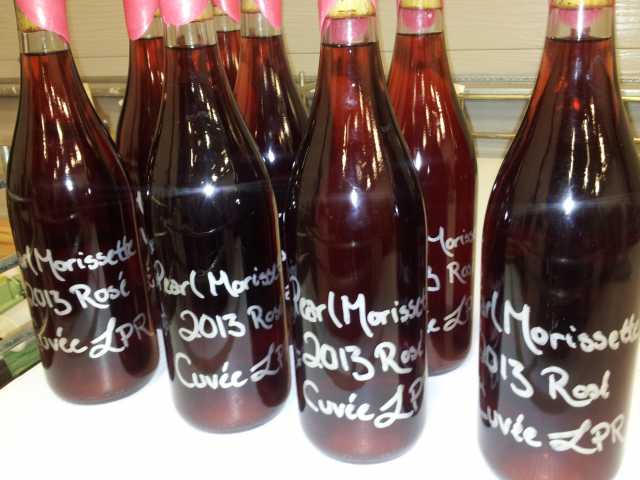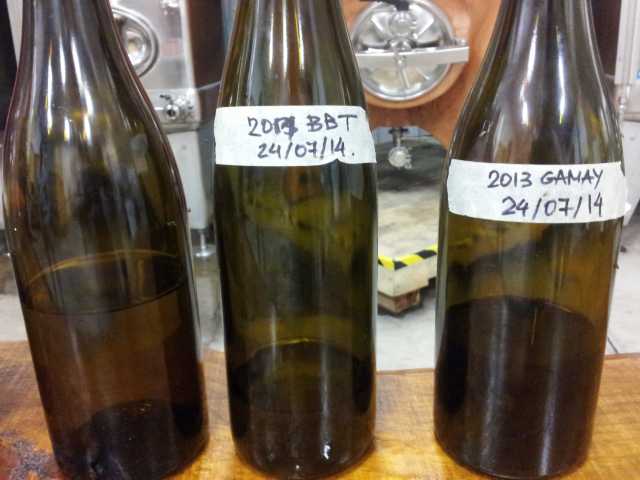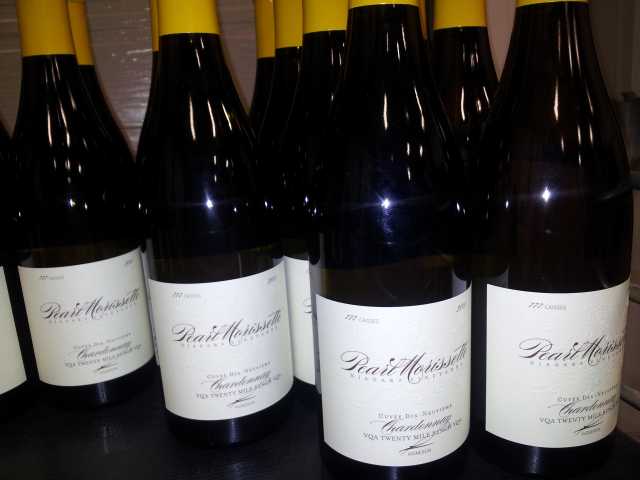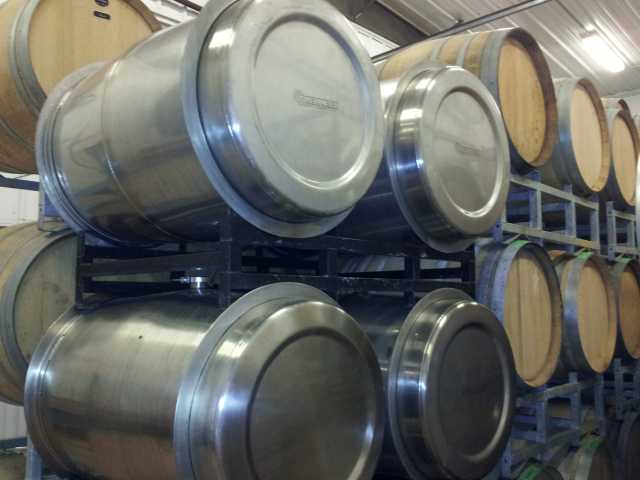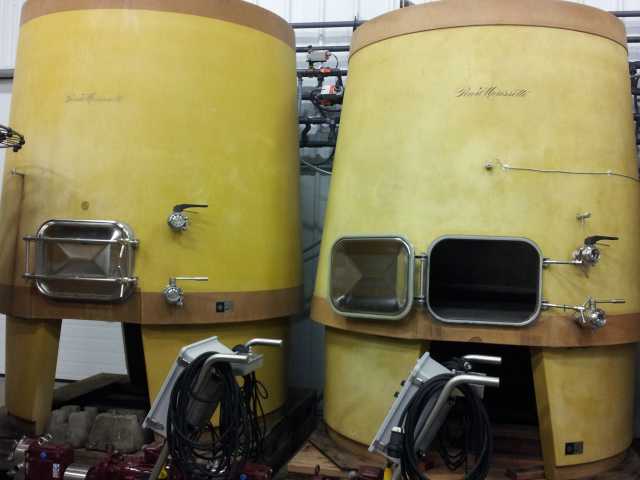Berserkers,
I spent a day in Niagara with fellow board member Jay Shampur and Michael Wright. Our first stop was an eye-opening and possibly life-changing visit to Pearl Morissette Estate Winery with a brief tour and extended and generous tasting both led by assistant winemaker Ryan Corrigan. The only other people present were an amiable American couple from Buffalo who were great French wine aficionados and had also heard of the winery and decided to visit.
Ryan is well-traveled and passionate about local winemaking and local farm to table wherever he has worked. He shares partner and head winemaker Francois Morissette’s vision of doing extraordinary things with Ontario terroir that people, myself included up until today, hadn’t previously thought possible with Ontario wine.
Ryan showed us some winemaking items that were brand-new since my last visit. They have brand-new unglazed concrete fermenters, oblong oak barriques from both Germany and Alsace specifically designed for Riesling, and stainless steel aging barrels which I had personally never seen before. Ryan informed me these were used to allow wines to age on lees outside of a fermenter.
Our first tasting was the 2012 Riesling Cuvée Blackball from barrel which knocked everyone’s socks off. As good as an Alsace Grand Cru Riesling costing 2-3 times more. Smells, looks, tastes and feels completely Alsacian in nature. A miracle of an Ontario Riesling and truly eye-opening.
Ryan then told us an interesting story about this wine. It failed the Vintner’s Quality Assocation tasting panel 4 times because the LCBO Product Consultant members of the panel told them that it tastes nothing like an Ontario Riesling. Notwithstanding that this was in fact the whole point, Pearl Morissette decided to forgo the VQA certification and sell it internationally where it made a killing.
Triumphantly and somewhat ironically, they managed to sell the wine in FRANCE, the home base of Alsace Riesling. As you might imagine, this would’ve made a stunning impression for Ontario wines on the world stage… if the wine had been given VQA certification. Instead, Pearl Morissette gets all the glory to themselves.
Ryan told us a funny story of how he and Mr. Morissette’s partners had to explain to him that they were essentially being blackballed by the VQA because his wines made their members very nervous and he didn’t understand what this English slang term meant at the time. So they explained it to him and they could literally see the light bulb going off in his head as they were explaining. He had just decided to name his wine. Our second tasting was the 2011 Riesling from bottle which was the last one they did with just steel aging alone before they had acquired the Riesling barriques. Still extremely Alsacian in style with high minerality and green apple notes.
Next was the 2012 Chardonnay. Extremely well done, this had the flavor of an Aubert from California but the delicacy of a Grand Cru Meursault from Burgundy. Given that I am a certified Chardonnay hater, this absolutely blew me away. How could an Ontario Chardonnay actually equal if not supercede old world Burgundy Chardonnay? With great skill and care, that’s how. Francois is Burgundy trained and in fact originally hails from France and moved his entire family to Ontario based on the potential he saw here. I actually bought a bottle of this! Me, an avowed Chardonnay hater! I BOUGHT THIS!!! ![]()
Next came another life-changer, their 2013 Cabernet Franc Cuvée LPR Rosé. This was a delicate strawberry perfumed wine with the body of a white Alsacian and incredible light yet complex strawberry flavors with a hint of tannin serving as a complement to the wine. It literally made me reconsider my entire approach to Rosé wine as I often wonder what a red wine would be like if unoaked and the maceration cut back so as to let the fruit and not the tannin and wood shine. I just got my answer. I am far too manly to drink Rosé wine and I bought a bottle of this too! Double ![]()
After a brief respite, we went on to the reds and were treated to two Pinot Noirs, a Cabernet Franc and a Gamay Noir all from unlabeled bottles.
The 2007 Estate Pinot Noir – A perfect emulation of Burgundian quality Pinot Noir, as good as any of the ones I had at Mike Grammer’s last Berserkerfest. Delicate, full of strawberry flavor, some light but firm tannins to give the wine structure. I’m sure the Burgundy lovers of the board would definitely be marveling over this one. Again, that they pulled this off with Ontario grapes is an incredible achievement. This is another wine that failed the VQA standards test 4 times forcing them to forgo the certification and sell internationally.
The 2012 Pinot Noir Cuvée Francoistein – Perfumed, delicate body, full of chai tea spices and red cherry fruit flavor. The name comes from the fact that they worked over three different Pinot Noirs to make this blend, one of which was considered “bad” and they were actually considering throwing away.
Ryan convinced Francois to let him experiment with the allegedly bad batch and he came up with the idea of draining the juice from the bottom of the ferment and repassing it over the must cap and top and letting it filter down again. This did the trick as the liquid extracted more fruit and tannin. Ryan told us that the major problem with large batch fermenting is that only the top part of the wine ever gets exposed to the cap.
Yes, everyone does a punchdown but Ryan says this really doesn’t ever expose all of the wine to the must cap and everyone knows this. That’s why he did an Italian Ripasso style repassing, albeit over the existing must cap, and it worked. Now happy with all the components, Ryan jokingly noted that Francois was putting together “a real Francoistein monster of a wine.” Francois eyes lit up again and Ryan said to him “Oh God, no, not that… really?” and tried to talk him out of it but Francois liked the name too much and stuck with it.
I did find this less refined and flavorful that their estate Pinot Noir, but in fairness Ryan pointed out that this wine was meant to be a less expensive wine more along the lines of a standard Ontario $19.95 CDN Pinot Noir that brought Burgundian quality for an Ontario level price. In other words, this is their attempt at a high QPR value wine. In this respect, they have succeeded remarkably.
The 2011 Cabernet Franc Cuvée Persephone was surprisingly delicate and full of black raspberry and herbal notes and flavors. Ontario Cabernet Franc has to be the red wine I detest the most from this province but this was nothing like them. It’s got the texture of a Burgundy Pinot Noir, in fact. I asked Ryan if they use micro-oxygenation and they are adamantly against the technique because while it does make a wine drinkable sooner they feel it will kill the wine in the long run. Nope, the delicacy is achieved through good old terroir, selective hand picking and skillful winemaking.
The 2013 Gamay Noir was all beautiful and delicate strawberry nose and flavors and was by far the most fruit-forward of the reds we tried. It is done deliberately in a Beaujolais style and came really close to Sangria notes, it was so fruity. I have personally always argued Ontario should do more with Gamay Noir and Baco Noir and asked Ryan how they felt about this. They are not big fans of Baco Noir themselves and have chosen not to do anything with it and want to concentrate on Gamay Noir, Pinot Noir and Cabernet Franc for their reds.
